Winter in Chopta transforms the region into a breathtaking snow-covered paradise. The Chopta Chandrashila trek in winter, offered through a Chopta tour package, provides an unforgettable experience with pristine white forests, frozen lakes, and panoramic Himalayan views, making it a dream destination for adventure seekers.
Along the route, the snow-laden trails leading to the Tungnath Temple Trek are surreal, providing a magical ambiance of tranquility and spiritual charm. Whether it’s witnessing the sunrise from Chandrashila summit or camping under starry skies in Chopta’s chilly winter nights, the beauty and serenity of the Himalayan landscape in this season are truly unmatched. For those looking to explore the majestic Himalayas in winter, Chopta is undoubtedly one of the best spots to embrace nature’s winter wonderland fully
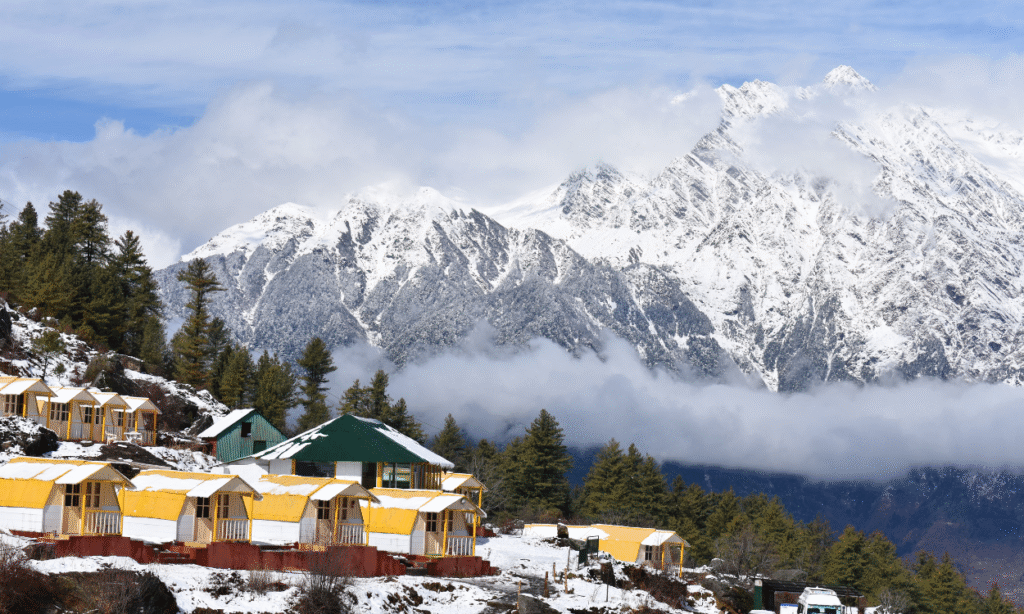
Snow-Covered Rhododendron Forests: Nature’s Winter Blanket
Winter in Chopta is nothing short of magical, especially when you witness the snow-covered Rhododendron forests, which act like nature’s perfect winter blanket. These forests, part of the serene trek routes like the Chopta Tungnath trek, transform into a surreal white wonderland during the cold months. Imagine walking through trails flanked by trees heavy with glistening snow, where the usual vibrant pink and red rhododendron blooms are replaced by snow-capped branches that sparkle under the winter sun. This unique landscape offers a peaceful and quiet retreat, as the pristine snow absorbs sound, creating a calm atmosphere perfect for reflection and nature appreciation.
The forests are a vital part of Chopta’s charm, giving trekkers a sensory experience that contrasts starkly with the loud hustle of city life. You can hear crunching snow underfoot and the occasional call of a Himalayan bird, while being surrounded by breathtaking views of towering Himalayan peaks peeking through the snowy woods. This is especially true on treks like the Chopta Chandrashila trek from Delhi, which invites adventurers to immerse themselves in these untouched winter scenes.
Besides their beauty, these Rhododendron forests shelter diverse Himalayan wildlife, some of which become more visible during the quieter winter months. As you trek through these winter forests, the combination of spirituality near the Tungnath temple trek and the pristine wilderness creates a truly memorable Himalayan adventure. Thus, the snow-covered Rhododendron forests in Chopta aren’t just landscapes; they are a magical experience wrapped in winter’s embrace.
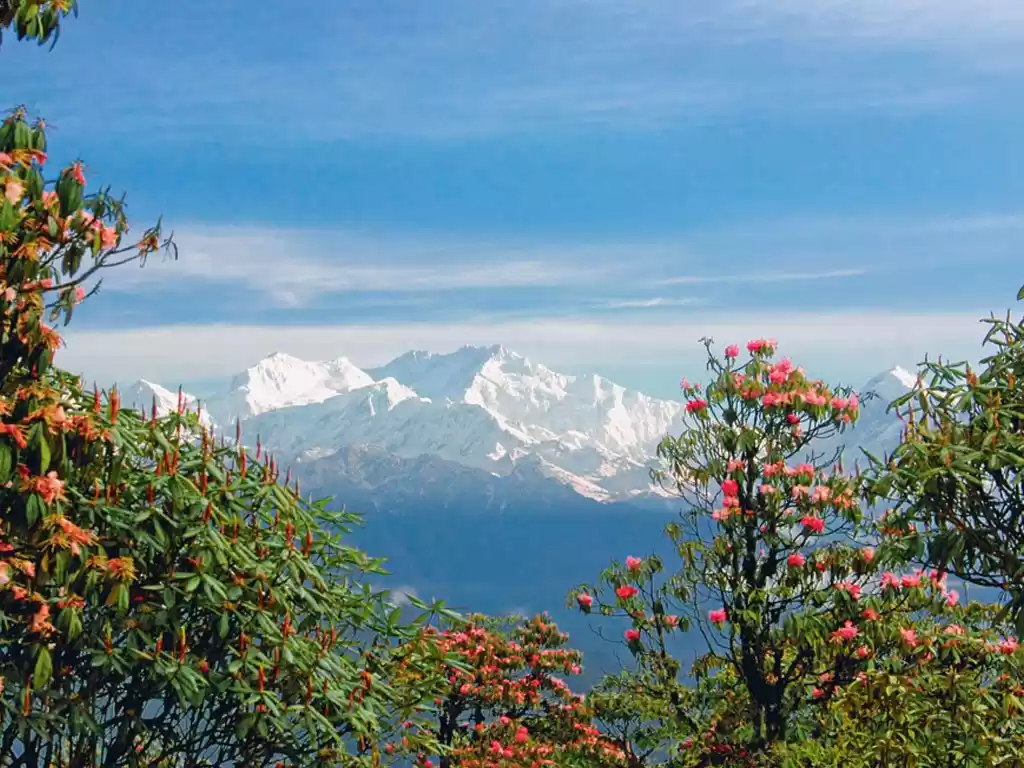
Sunrise Magic from Chandrashila Peak
Watching the sunrise from Chandrashila peak is a truly magical experience you shouldn’t miss while on the Chopta Chandrashila trek. This trek is known for its easy to moderate difficulty, making it accessible for most people who enjoy walking in the mountains. The trail begins in Chopta, a quiet village surrounded by tall forests of pine, oak, and rhododendron trees. From Chopta, you first hike to the Tungnath temple, the highest Shiva temple in the world, located at about 3,500 meters. After visiting the temple, the final climb to Chandrashila summit, which is at 3,700 meters, is a bit steep but takes less than an hour.
When you reach the top early in the morning, you can watch the first light of the day spread over the snow-capped Himalayan peaks like Nanda Devi and Trisul. The soft golden colors of the sunrise lighting up the snowy mountains are a breathtaking sight. The fresh, cold air, the quiet surroundings, and the stunning views combine to give you a peaceful and uplifting feeling. Many trekkers say this moment feels almost spiritual, especially after the climb.
If you’re planning your trip in winter, the views get even more magical with snow-covered landscapes all around. The trail might be slippery, so it’s important to wear good shoes and take your time. Whether on a Chopta tour package or trekking independently, catching the sunrise at Chandrashila is one of the best reasons to visit Chopta and take the Chopta Tungnath trek. It promises memories that will last a lifetime.
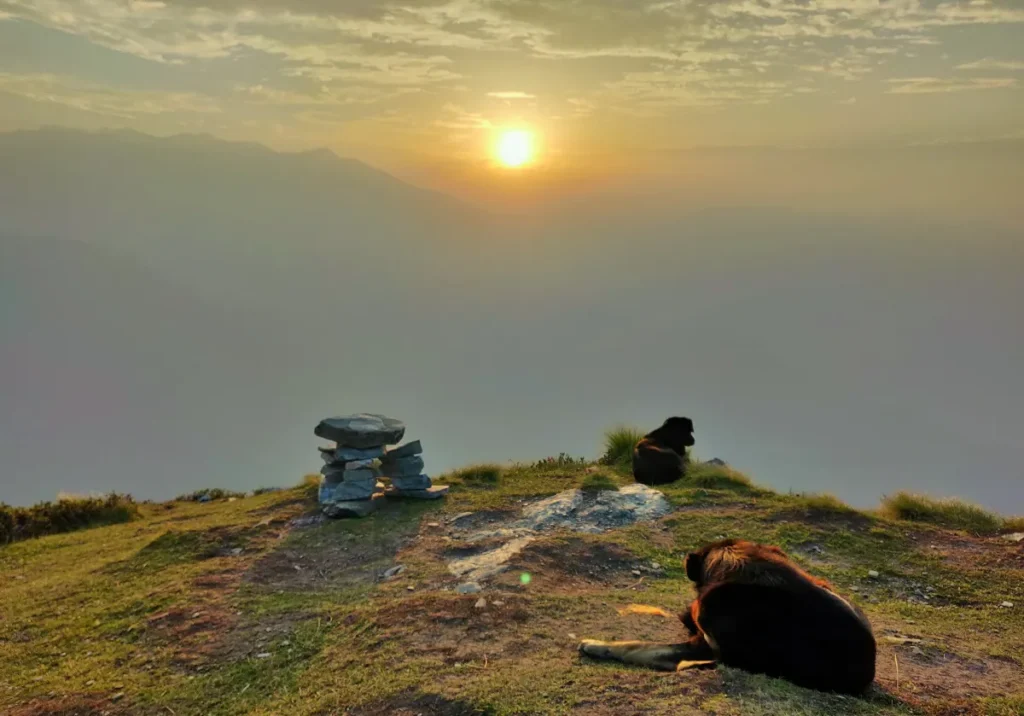
Panoramic Himalayan Peaks: Nanda Devi, Trisul, and More
The panoramic view of Himalayan peaks like Nanda Devi, Trisul, and others from Chopta is an unforgettable experience, especially during the popular Chopta Chandrashila trek. Standing at the Chandrashila summit, about 3,700 meters above sea level, trekkers are greeted with breathtaking 360-degree views of some of India’s tallest and most famous mountains. Nanda Devi, the second highest peak in India, stands proudly among the ranges, while Trisul’s three majestic peaks seem to guard the valley below. These mountains look even more stunning during winter when fresh snow covers their slopes, shining brightly under the morning sun.
This trek from Chopta is well-traveled and loved for blending adventure with these amazing views. The path takes you through green meadows and dense forests before reaching the Tungnath temple, which is the highest Shiva temple in the world. From there, it is a short but steep climb to the Chandrashila peak, where you can enjoy the panoramic Himalayan sights.
Frozen Deoria Tal: A Picture-Perfect Winter Lake
Deoria Tal is a beautiful lake located near Chopta, and it becomes even more magical in winter when it freezes and gets covered with snow. The view of the frozen lake surrounded by snow-covered trees and mountain peaks is truly picture-perfect. Trekkers who take the Chopta Tungnath trek often include Deoria Tal as a must-visit spot because of its peaceful atmosphere and stunning winter beauty.
During winter, the lake’s surface can freeze, creating a quiet world of white that looks like a scene from a fairy tale. The snow around the lake sparkles in the cold sunlight, and the reflection of the snow-clad mountains, especially the Chaukhamba peaks, on the icy water makes for amazing photo opportunities. Visitors can enjoy a peaceful walk by the lake, surrounded by tall trees also covered in snow.
The trek to Deoria Tal is not very long but offers a great chance to explore Chopta’s winter landscapes. Many who come on a Chopta tour package take this trek to see the frozen lake and enjoy snow trekking and camping nearby. The calm environment away from city noise makes Deoria Tal an ideal spot for those wanting to experience nature’s quiet beauty. Whether you want to relax by the lake or capture breathtaking views of the Himalayas, Frozen Deoria Tal is a winter destination that promises unforgettable memories.
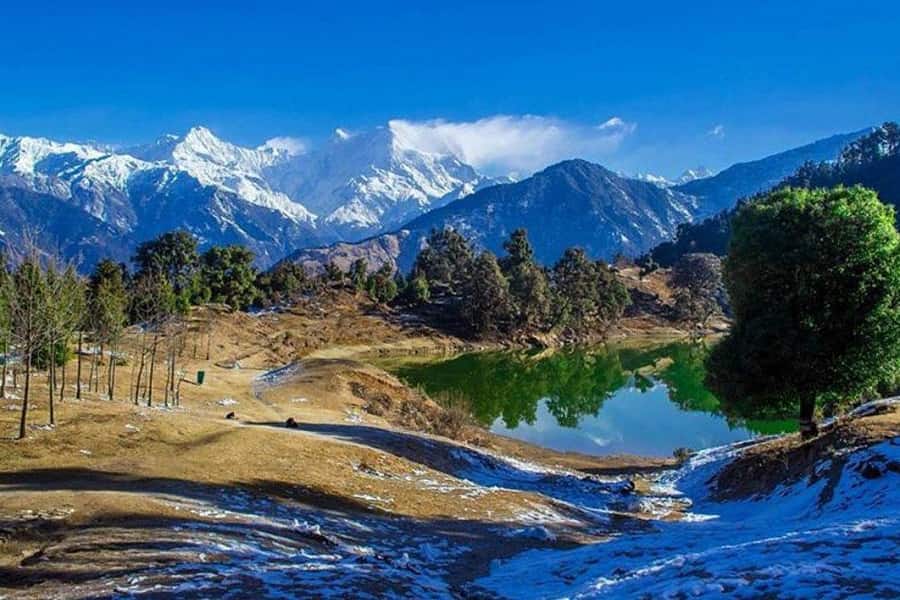
Snow-Laden Trails on the Tungnath Temple Trek
The Tungnath temple trek is a popular winter adventure for many trekkers visiting Chopta. During winter, the trails leading to the temple are covered with fresh snow, creating a magical white landscape. Walking on these snow-laden trails, surrounded by snow-covered trees and mountain views, is an experience unlike any other. The peaceful silence, broken only by the crunching of snow underfoot, adds to the beauty of this spiritual trek.
The trek starts from Chopta, leading you through forest paths, rhododendron and oak trees, all dusted with snow during the chilly months. It’s important to wear warm clothes and proper trekking boots because the snow can make the ground slippery. Many travelers who choose a Chopta tour package in winter highlight the thrill and calmness found on these snowy paths.
At 3,680 meters, Tungnath Temple is the highest Shiva temple in the world, and visiting it in the winter feels even more special with the white snow all around. The temple area, though often covered in thick snow, welcomes pilgrims and trekkers who carefully manage the cold conditions. The route also treats you to spectacular views of snow-covered Himalayan peaks like Nanda Devi, Trisul, and Chaukhamba.
Starry Winter Nights: Camping Under the Himalayan Sky
Camping under the clear, starry winter sky in Chopta is a magical experience that every nature lover should try. During winter, the air is crisp and clear, which means you get some of the best views of the stars and the Milky Way. When you choose a Chopta tour package that includes camping, you can enjoy peaceful nights away from city lights, surrounded by the quiet beauty of the Himalayas.
The camping sites near Chopta, especially around the Tungnath temple trek and Chandrashila summit, offer perfect spots to set up a tent and watch the sky come alive with stars. The cold winter nights make the stars appear sharper and brighter, creating a spectacular view that stays with you long after you return home. Sitting by a campfire, sharing stories, and feeling the calmness of the mountains under that vast sky is truly special.
Being in the high Himalayas means the nights get very cold in winter, so it’s important to be well-prepared with warm sleeping bags and clothing. But the effort is worth it when you see the clear skies filled with countless twinkling stars. Many trekkers say that camping on the Chopta Tungnath trek is one of the most memorable parts of their journey.
Whether you are a beginner or an experienced camper, spending starry nights in Chopta during winter offers a unique chance to connect with nature and the majestic Himalayan environment. This experience adds a magical touch to any Chopta trekking tour and makes winter visits truly unforgettable.
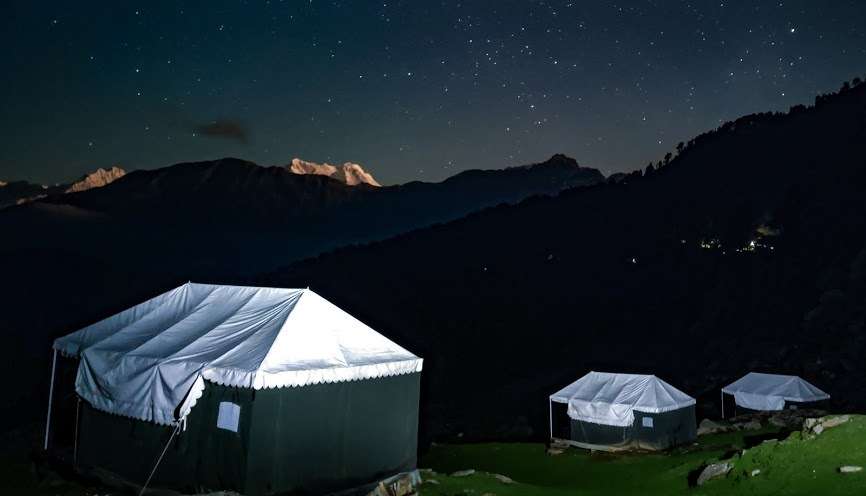
Crystal Clear Skies Offering Unmatched Visibility
One of the most beautiful things about visiting Chopta in winter is the crystal clear skies that offer unmatched visibility of the Himalayan mountain range. Unlike many other places where clouds and pollution can hide the views, Chopta’s winter air is fresh and free of pollution, making the skies sharp and clear. This clarity means you can see famous peaks like Nanda Devi, Trisul, Chaukhamba, and many more in great detail. Trekkers often say that the view of these snow-capped mountains under a clear blue sky is one of the best parts of the Chopta Tungnath trek and the Chopta Chandrashila trek.
The cold winter months bring stable weather and less fog, giving visitors unforgettable panoramic views throughout the day. Early mornings are especially clear, which is perfect for photography and enjoying peaceful moments with nature. The village of Chopta itself, often called the “Mini Switzerland of India,” wakes up to these stunning views, where the hills and forests sparkle under the sunlight.
The sharp visibility is a great advantage for travelers who are part of any Chopta tour package because it ensures that the effort to reach these heights is rewarded with breathtaking sights. Whether you are hiking to Tungnath temple, camping under the Himalayan sky, or heading towards the Chandrashila summit, you will feel amazed by how many mountain peaks you can spot on a clear winter day.
For anyone dreaming of a winter trek with stunning mountain views, Chopta’s crystal clear skies offer a perfect setting. It’s a natural gift that makes winter the best season to visit Chopta for unmatched Himalayan visibility.
Icy Streams and Snow-Kissed Mountain Edges
One of the most beautiful sights during the winter season in Chopta is the rivers and streams that freeze partially, creating icy streams that shimmer in the cold mountain air. These icy streams flow gently alongside the snow-kissed edges of the mountains, creating a peaceful and almost magical atmosphere. When trekking the Chopta Tungnath trek or the Chopta Chandrashila trek, you will often come across these icy waters, which add to the unique winter charm of the Himalayas.
The snow-kissed mountain edges give the landscape a soft, white outline, making every ridge and slope look like a painting. As you walk along the trails, the contrast between the icy blue streams and the white snow makes for stunning views and great photo opportunities. These natural features are a sign of the winter’s cold but beautiful grip on the region, turning it into a wonderland for trekkers and nature lovers.
The crisp air and quiet surroundings found near these icy streams create a sense of peace and solitude, offering a perfect break from busy city life. Many people coming on a Chopta tour package find these moments by the icy streams as some of the most memorable parts of their trip.
The partially frozen streams near the Tungnath temple trek add to the joy of the journey, reflecting the snow-kissed mountains and the clear blue sky above. This amazing winter scenery is just one of the many reasons why Chopta is a top destination for winter trekking and nature exploration in the Indian Himalayas.

Wildlife Sightings Amidst the Winter Silence
One of the unique experiences during a winter trek in Chopta is spotting wildlife amidst the peaceful, snowy silence. The quiet environment of winter allows trekkers on the Chopta Tungnath trek and Chopta Chandrashila trek to notice animals and birds that are usually hard to spot. Even though the cold weather makes many animals less active, some wildlife adapts to the winter conditions and can be seen for those who look closely.
You might see Himalayan birds like the monal, which is known for its bright colors, even in the snow-covered forest. Other animals like musk deer and Himalayan tahrs sometimes make appearances near the snow-covered trails. These glimpses of wildlife add an exciting and special touch to the trek, as they show how life continues calmly and beautifully even in the cold season.
The winter silence in Chopta creates a perfect atmosphere for observing this wildlife without disturbance. Trekking through the snow-laden forests and meadows, you can enjoy the rare chance to see animals in their natural habitat, making your journey more memorable.
Many travelers who choose a Chopta tour package mention wildlife sightings as one of the best parts of their trip. The mix of snow, quiet nature, and glimpses of Himalayan wildlife offers a truly unique winter experience. For nature lovers, witnessing wildlife amidst the winter silence of Chopta is a special reward during the Himalayan winter trek.
The Silent Beauty of Chopta’s Snowy Meadows (Bugyals)
Chopta is famous for its beautiful meadows, known locally as Bugyals, and visiting them in winter is a special experience. During this season, these Bugyals are covered in a thick blanket of snow that makes everything look peaceful and pure. The white snow turns these meadows into silent, quiet places where you can enjoy nature in its simplest form.
Walking through the snowy Bugyals on treks like the Chopta Tungnath Trek is like stepping into a winter wonderland. The meadows stretch out wide, surrounded by snow-covered trees and distant Himalayan peaks, offering some of the most calming and beautiful views in the region. Without the usual crowds, you may find moments of complete solitude, listening only to the soft crunch of snow beneath your feet.
These snow-covered Bugyals also provide excellent spots for camping if you join a Chopta tour package during the winter. Spending a night in a tent on these silent meadows under the stars is an unforgettable Himalayan adventure. The cool, fresh air and the stunning views of the snowy landscape make it a perfect place to relax and connect with nature.
For nature lovers and trekkers, Chopta’s snowy Bugyals hold a silent beauty that captures the heart and creates lasting memories of winter in the Himalayas. They remind visitors of the peacefulness and grandeur of the mountains during the cold season.
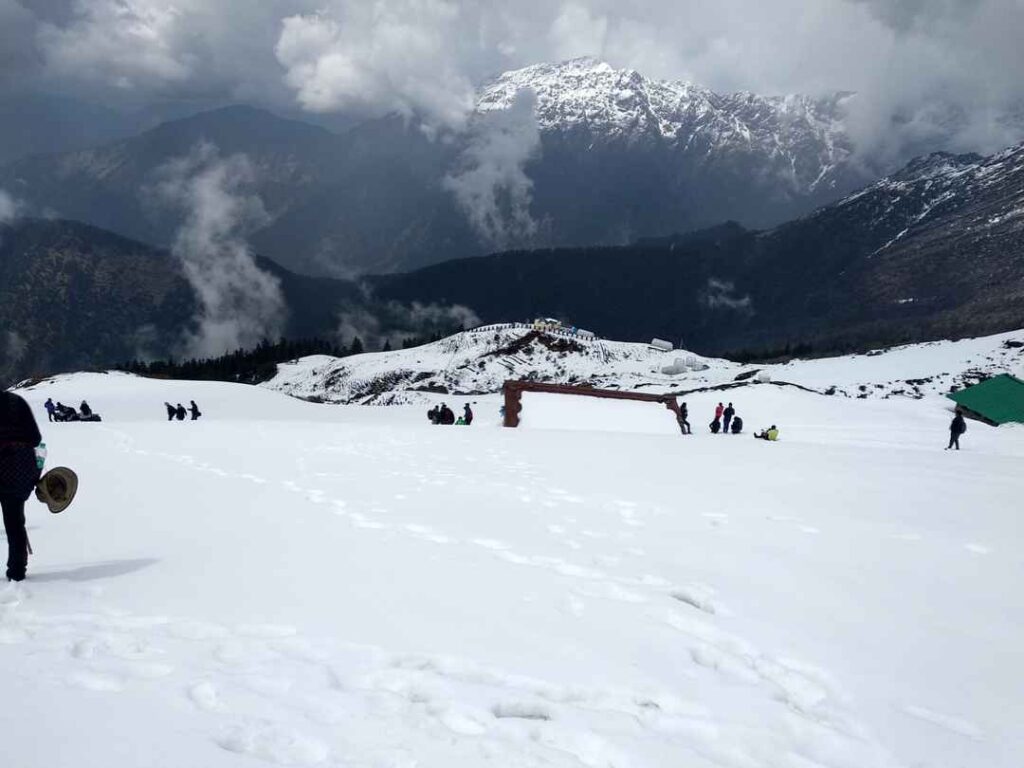
Frequently Asked Questions
- When is the best time to visit Chopta for winter trekking?
The best time for winter trekking in Chopta is from November to February when the region is covered with snow, offering stunning winter views. The weather is cold but usually clear, perfect for panoramic Himalayan visibility. - How difficult is the Chopta Tungnath trek during winter?
The trek is considered easy to moderate. Winter snow adds challenge by making trails slippery and steep near the summit but with proper gear and fitness, it is manageable for most trekkers. - What kind of clothing and gear should I carry for a winter trek in Chopta?
Warm layered clothing, trekking boots with good grip, gaiters, crampons, gloves, woolen caps, and waterproof jackets are essential. Extra socks and thermal wear are recommended due to cold and snow. - Are the Chopta Chandrashila and Tungnath treks open during heavy snowfall?
They remain open but can be risky during heavy snowfall and icy conditions. It’s best to trek with a guide and check weather updates before venturing. - How long does the Chopta Chandrashila trek take in winter?
Typically, a 3-4 day trip covering about 8-10 km round trip, including stops at Chopta village and the Chandrashila summit. - Can I see Himalayan wildlife during the winter trek in Chopta?
Yes, winter’s silence makes wildlife sightings like Himalayan monal birds, musk deer, and tahrs more noticeable along the snow-laden forest trails. - What are the must-see winter views and landscapes in Chopta?
Snow-covered Rhododendron forests, panoramic mountain peaks including Nanda Devi and Trisul, frozen Deoria Tal lake, and the snow-kissed meadows (Bugyals) are highlights. - Are there camping facilities available during the winter season in Chopta?
Yes, camping is popular especially near Chopta and along the trek routes like near Tungnath temple and Chandrashila summit, offering starry winter nights under clear skies. - Is it safe to trek alone during winter, or should I hire a guide?
Hiring a local guide is strongly recommended, especially in winter, due to slippery trails, changing weather, and snow-covered paths. - How clear are the mountain views from Chopta in winter?
Winter offers crystal clear skies with unmatched visibility, giving panoramic views of peaks like Chaukhamba, Nanda Devi, Trisul, and more. - Is Deoria Tal accessible in winter, and what’s special about it during this season?
Yes, Deoria Tal is often frozen in winter, providing a picture-perfect frozen lake surrounded by snow-covered forests and Himalayan panoramas. - What precautions should I take when trekking the snow-laden trails on the Tungnath temple trek?
Wear proper snow gear, use trekking poles, keep steady to avoid slipping, start early to avoid afternoon weather changes, and stay hydrated. - Are there any restrictions or special permits required for winter trekking in Chopta?
No special permits are generally required for trekking in winter, but it is advised to check local guidelines and travel with a registered guide or group for safety.

